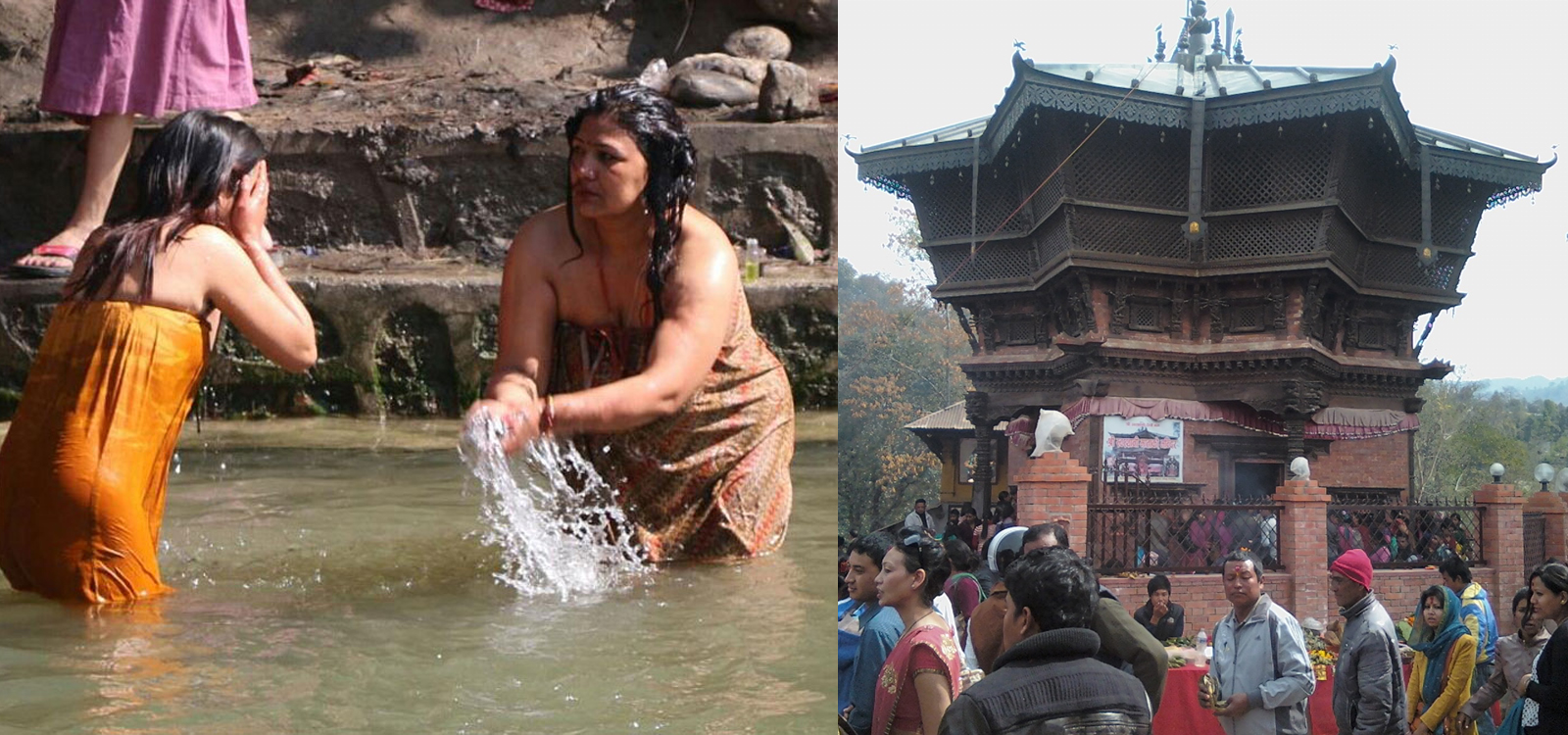Many of us grew up hearing Goddess Swasthani’s tale and the numerous myths and characters in the narrative. We have also seen many individuals fasting for one full month for Madhav Narayan but not many of us realize that all of those tales and narratives are related to the Salinadi, located in Sankhu. This river flows below Sankhu Bazaar. There are idols of Mahadev, Swasthani, Ganesh, Nagnagini, Hanuman, Badrinath, Vasuki etc. on the riverbank.
Salinadi in the northeast part of the Kathmandu Valley is the former Newari settlement, which is located approximately 17 kilometres from the Thamel tourist center, Kathmandu. You can get access to Salinadi within 1 hours from Thamel. Sankhu’s remarkable old Sankha-shaped town building is also called Shankharapur. Salinadi is like an appealing site for Hindu worshippers, where extreme crowds can be observed in the Poush/Magh month (Nepalese Calendar). As Hindus worship Swasthani in Nepal and read her narrative, many Hindu followers fast during this month and praise the goddess Swasthani. Because of the Salinadi fair, Sankhu is very popular among the tourists.
As Sankhu is a Newar community, various Newar communities celebrate different traditional festivals in the Salinadi River. During your visit to this holy river, you will get an opportunity to learn about Newar lifestyle and their festivities at the base of Sankhu regions. In addition, Sankhu Salinadi is also a gateway to Nagarkot trek. The trip is 3-4 hours long from Sankhu, Salinadi.
Premises around Salinadi Temple
A gold-plated roof with wooden stones, which resembles the sculptures of the goddess Swasthani, with a lion which is used as her vahans (vehicles), rests on the hilltop on the banks of Salinadi. This temple is also known as a Swasthani Mata temple. Inside a house, devoted people worship and offer homage to Goddess Swasthani asking to bless them with long-term life, prosperity, and children. There is a great statue of the deity sitting on the lion. There is also a huge fire hall where believers offer homage to sacred fir to impress goddesses.
You have to pass through a road of steep stairs to reach the river from the temple. Likewise, a few miles away from the temple, there is a tiny stone cottage, which is supposed to be the abode of Goma Brahmin (the mythological figure in Swasthani) with several stone homes nearby.
Salinadi Fair
In Salinadi temple, a yearly fair is held known as Salinadi Mela. According to Hindu scriptures, Vishnu taught Parvati the method of fasting for the motherland. Parvati fasted on the bank of the river and found Mahadev as her husband. Therefore, it is customary to fast in the Shali river area with the idol of Madhav Narayan as a witness.
Thousands of pilgrims and residents take part in this event. The fair is held every year. The fair displays many things created locally, such as food, clothes, and jewels. Khuwa and lapsi pickles are especially sold during this fair. There are so many religious values in this river temple and goddesses are adorned in this location with great faith. Many devotees visit Sankhu, Salinadi, for traditional holy baths in the Salinadi river, during the month of Magh. It’s claimed that a ceremonial bath in the Salinadi River may take away all sins and evil actions.
Swasthani Barta
The festival is held every year, in the ninth month of the Nepalese calendar i.e., on the first full-moon day of Poush (January), at the Salinadi temple. Pilgrims also read the narrative of the goddess Swasthani and Lord Shiva, and adorned Goddess Shree Swasthani in other temples around Nepal during the month of Poush.
In Nepal it is also called Swasthani Puja. The devotees eat just once a day for a month, take the holy bath constantly in the morning and wear pure garments, which have been washed every day. While going through the Swasthani Book all hands and feet should be well trimmed. They recite 31-chapter of Swasthani Barta Katha (a holy scripture dedicated to Swasthani Mata). Especially millions of Hindus women from Nepal fast during this month for the long and happy life of their husband. Unmarried women also fast to get an ideal husband in the future. The festival ends with an Ashwamegha yagna. In this yagna, pilgrims worship Lord Shiva for a whole night.
How to get there?
Salinadi is easily accessible from Ratnapark bus station. Several buses depart from Ratnapark every day towards Salinadi. During the month of Poush/Magh, the buses are over-crowded with a lot of pilgrims. It takes 2-3 hours to reach Salinadi. However, if you hire a taxi or drive in private vehicles, then you reach there within an hour.
Salinadi temple, which carries historical significance, is the best holy location where a nice memory can be created on vacation. If you want to avoid crowds, then plan your visit in other months besides Poush/Magh. However, it is religiously important and fun to visit this river during these months because of beautiful cultural environment.
-By: Kusum Kharel for Land Nepal




